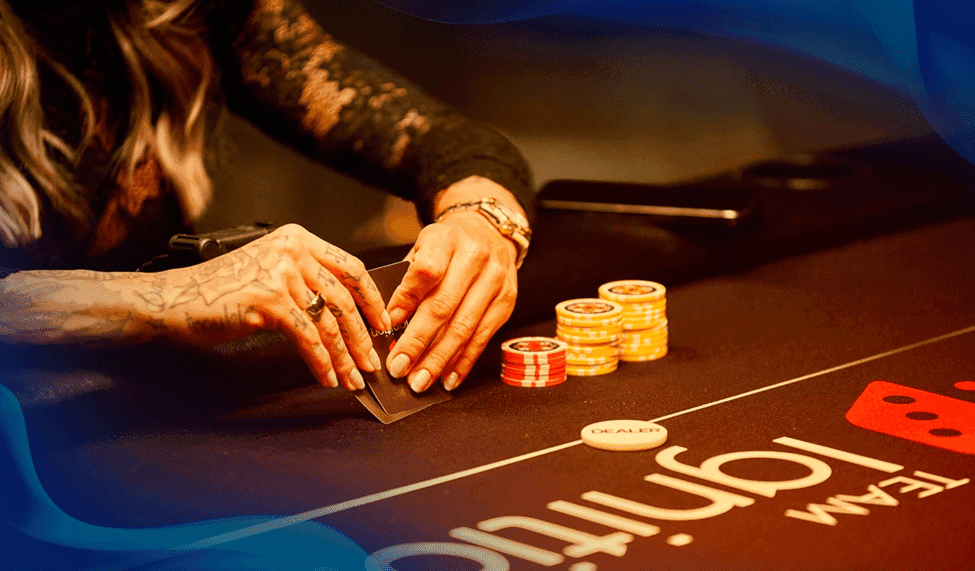
Think poker is all about luck? Think again. A delicate balance of wits and nerve, only the most mindful and strategic survive on this battlefield. Put simply, poker is a mind game — and the only way to make it to the end is to master it.
The first step to improving in poker is by sharpening your statistical thinking skills, opponent-reading, and resilience. Discover everything you need to hold your own on the felt, including poker strategy tips and insights on the mental game of poker.
The Perfect Equation: The Mathematic & Mental Game of Poker
Poker blends probability and psychology into one heart-pounding package. Although it isn’t a game of luck, it is a game of odds. So, to succeed, you need to wrap your head around one core mathematic principle: statistics. This is what will help you calculate your odds based on your hand, position, and more.
Get familiar with different poker hands and how they might fare depending on your position. The more you understand your odds of winning with any hand, the more confident you’ll feel in deciding to call, fold, or raise.

Becoming Unshakeable: Emotional Control
While poker is highly technical, it’s also super emotional. The exhilaration you feel after a massive win? The devastation that comes with a bad beat? Your heart is in it as much as your head — and, if you’re not careful, sometimes even more.
Learning how to handle your feelings on the felt is crucial. For example, if you’re suffering from tilt — frustration and anger after a tough loss — and you let it overpower you, the consequences could be dire. Your judgment could be clouded, you could make one wrong move, and before you know it, you could have nothing.
So, to master the mental game of poker, focus on building the right mindset. Prioritize long-term success over short-term outcomes. Detach your emotions from immediate results in order to stay calm and consistent under pressure. If you feel like your feelings are taking control, explore techniques like meditation, controlled breathing, and taking quick breaks.
The Art of Bluffing: When & How to Pull It Off
Bluffing is the art of deceiving your opponents into thinking you have a stronger hand than you actually do. And when you’re learning how to improve in poker, mastering it is crucial.
Bluffing works so well because it allows you to exploit human behaviors to your advantage. For example, someone could be overconfident about their hand. By bluffing, you’ll make them second-guess that assurance and rethink their next move. On the flip side, someone could be terrified of losing. With a clever bluff, you could have them folding in a heartbeat.

Of course, bluffing is only effective if you know how to do it. A great starting point is controlling your body language. Make a concerted effort to mask any ticks or tells you might have. Avoid fidgeting, and keep your face relaxed and neutral.
With that said, you don’t have to stay dead quiet. In fact, talking to your competitors can actually play to your advantage, according to multimillion-dollar-winning poker pro Daniel Cates. According to him, talking displays confidence, which can throw off your opponents.
“You’ll probably have some success by talking when you are bluffing because [your opponents] don’t expect that,” he says. “I have found, in my experience, talking gets people to fold more.”
Looking Behind the Mask: Reading Your Competitors
It’s one of the most basic poker strategy tips but also one of the most important: learn to read your opponents.
When you know what’s on the other side of their cards, you’re in control. You have the power to make smarter decisions, whether it’s to call, fold, or raise.
But how can you actually figure out what they’re holding?
Step one is identifying their tells. Pay close attention to their movements and behaviors. Maybe they bounce their knee ever-so-slightly when they have a crappy hand. Maybe they bite their lip when they’ve got an awesome hand. Whatever they may be, suss them out as quickly as you can. Then, use them to inform your next move.
Once you become a little more skilled, you can even start categorizing your competitors based on their playstyles. The four core categories include:
- Tight Passive: Predictable and timid, these players are easy to bluff and fold frequently when faced with aggression.
- Loose Passive: These players are risk-averse and typically fall into the trap of calling nonstop. That said, they’re not as easy to bluff as tight passives.
- Tight Aggressive: These players play fewer hands but aren’t afraid to bet. They’re known for being patient and waiting for the perfect opportunity to strike.
- Loose Aggressive: The most unpredictable of the bunch, these players are extremely hard to read. That said, they’re not overly hard to beat because their lack of consistency leaves them vulnerable.
Once you know which group an opponent belongs to, you’ll be better prepared to play against them.
Get More Poker Strategy Tips from a Certified Pro
Equal parts strategy and psychology, the mental game of poker demands a unique set of skills. A knack for statistics, stellar emotional regulation, a keen eye for competitors’ tells — these are traits that need to be perfected both on and off the felt.
Want to learn how to improve in poker even more? Get expert insights directly from world-renowned pro Daniel Cates in the newest episode of The Team Ignition Show. Hear all about his iconic career, tips for beginners, and plans for the future.



